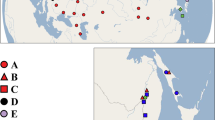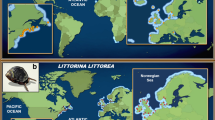Abstract
Planktonic developing organisms are generally assumed to be good dispersers showing little genetic structuring in neutral markers. At first glance, this also applies to the planktonic developing periwinkle Tectarius striatus, an endemic gastropod from Macaronesia (i.e. Azores, Madeira, Canary Islands and Cape Verde Islands), where the only sign of genetic structuring hitherto is provided by a non-significant allozyme/RAPD heterogeneity between the Cape Verde Islands and the other archipelagos. However, partial sequences of the mitochondrial cytochrome b and cytochrome oxidase I genes now show that the Cape Verde Islands and the three other archipelagos have no haplotypes in common, whereas the latter three do share several haplotypes. Nevertheless, this highly disjunct haplotype distribution does not entail a phylogeographic break separating the haplotypes of both areas in two reciprocally monophyletic groups. This remarkable geographic and phylogenetic structuring may be explained by assuming that T. striatus colonized the Macaronesian archipelagos in periods when sea levels were lower (and/or volcanic activity was higher), so that seamounts peaked above sea level and could act as stepping-stones. Yet, after the last glacial period seamounts submerged, thus preventing further stepping-stones mediated dispersal of T. striatus between the Cape Verde Islands and the other archipelagos, while not affecting dispersal among the latter because of their closer proximity and connectivity. Hence, these contrasting patterns of neutral genetic variation in T. striatus show that genetic structuring in planktonic developing species may be far more complex than is usually assumed.


Similar content being viewed by others
References
Ávila SP, Azevedo JMN (1997) Shallow-water molluscs from the Formigas islets, Azores, collected during the “Santa Maria e Formigas 1990” scientific expedition. Açoreana 8:323–330
Avise JC (2000) Phylogeography: the history and formation of species. Harvard University Press, Cambridge
Avise JC (2004) Molecular markers, natural history and evolution, 2nd edn. Sinauer Associates, Sunderland
Barber PH, Palumbi SR, Erdmann MV, Moosa MK (2002) Sharp genetic breaks among populations of Haptosquilla pulchella (Stomatopoda) indicate limits to larval transport: patterns, causes, and consequences. Mol Ecol 11:659–674
Clement M, Posada D, Crandall KA (2000) TCS: a computer program to estimate gene genealogies. Mol Ecol 9:1657–1659
De Wolf H, Backeljau T, Medeiros R, Verhagen R (1997) Microgeographical shell variation in Littorina striata, a planktonic developing periwinkle. Mar Biol 129:331–342
De Wolf H, Backeljau T, Van Dongen S, Verhagen R (1998a) Large-scale patterns of shell variation in Littorina striata, a planktonic developing periwinkle from Macaronesia (Mollusca: Prosobranchia). Mar Biol 131:309–317
De Wolf H, Backeljau T, Verhagen R (1998b) Congruence between allozyme and RAPD data in assessing macrogeographical genetic variation in the periwinkle Littorina striata (Mollusca, Gastropoda). Heredity 81:486–492
De Wolf H, Backeljau T, Verhagen R (1998c) Lack of significant esterase and myoglobin differentiation in the periwinkle, Littorina striata (Gastropoda, Prosobranchia). Hydrobiologia 378:27–32
De Wolf H, Backeljau T, Verhagen R (1998d) Spatio-temporal genetic structure and gene flow between two distinct shell morphs of the planktonic developing periwinkle Littorina striata (Mollusca: Prosobranchia). Mar Ecol Prog Ser 163:155–163
De Wolf H, Verhagen R, Backeljau T (2000) Large scale population structure and gene flow in the planktonic developing periwinkle, Littorina striata, in Macaronesia (Mollusca: Gastropoda). J Exp Mar Biol Ecol 246:69–83
Domingues VS, Almada VC, Santos RS, Brito A, Bernardi G (2007) Phylogeography and evolution of the Tripterygion delaisi (Pisces, Blennioidei). Mar Biol 150:509–519
Excoffier L, Smouse PE (1994) Using allele frequencies and geographic subdivision to reconstruct gene trees within a species: molecular variance parsimony. Genetics 136:343–359
Folmer O, Black M, Hoeh W, Lutz R, Vrijenhoek R (1994) DNA primers for amplification of mitochondrial cytochrome c oxidase subunit I from diverse metazoan invertebrates. Mol Mar Biol Biotechnol 3:294–299
Gad G, Schminke HK (2004) How important are seamounts for the dispersal of interstitial meiofauna? Arch Fish Mar Res 51:43–54
Geldmacher J, Hoernle K (2000) The 72 Ma geochemical evolution of the Madeira hotspot (eastern North Atlantic): recycling of Paleozoic (≤500 Ma) oceanic lithosphere. Earth Planet Sci Lett 183:73–92
Geldmacher J, Hoernle K, van den Bogaard P, Zankl G, Garbe-Schonberg D (2001) Earlier history of the ≥70-Ma-old Canary hotspot based on the temporal and geochemical evolution of the Selvagen Archipelago and neighboring seamounts in the eastern North Atlantic. J Volcanol Geotherm Res 111:55–87
Gillet P, Dauvin JC (2000) Polychaetes from the Atlantic seamounts of the southern Azores: biogeographical distribution and reproductive patterns. J Mar Biol Assoc UK 80:1019–1029
Hasegawa M, Kishino H, Yano TA (1985) Dating of the human ape splitting by a molecular clock of mitochondrial DNA. J Mol Evol 22:160–174
Hedgecock D (1986) Is gene flow from pelagic larval dispersal important in the adaptation and evolution of marine invertebrates. Bull Mar Sci 39:550–564
Hellberg ME, Burton RS, Neigel JE, Palumbi SR (2002) Genetic assessment of connectivity among marine populations. Bull Mar Sci 70:273–290
Hernandez-Guerra A, Fraile-Nuez E, Borges R, Lopez-Laatzen F, Velez-Belchi P, Parrilla G, Muller TJ (2003) Transport variability in the Lanzarote passage (eastern boundary current of the North Atlantic subtropical Gyre). Deep Sea Res Part I Oceanogr Res Pap 50:189–200
Johannesson K (1988) The paradox of Rockall—Why is a brooding gastropod (Littorina saxatilis) more widespread than one having a planktonic larval dispersal stage (Littorina littorea). Mar Biol 99:507–513
Jolly MT, Jollivet D, Gentil F, Thiebaut E, Viard F (2005) Sharp genetic break between Atlantic and English Channel populations of the polychaete Pectinaria koreni, along the North coast of France. Heredity 94:23–32
Landau B, Marquet R, Grigis M (2003) The early Pliocene Gastropoda (Mollusca) of Estepona, Southern Spain. Part 2: Orthogastropoda, Neotaenioglossa. Palaeontos 4:1–109
Lee T, Ó Foighil D (2004) Hidden Floridian biodiversity: mitochondrial and nuclear gene trees reveal four cryptic species within the scorched mussel, Brachidontes exustus, species complex. Mol Ecol 13:3527–3542
Mardulyn P (2001) Phylogeography of the Vosges mountains populations of Gonioctena pallida (Coleoptera: Chrysomelidae): a nested clade analysis of mitochondrial DNA haplotypes. Mol Ecol 10:1751–1763
Mitchell-Thomé RC (1976) Geology of the Middle Atlantic Islands, Gebruder Borntraeger, Berlin
Mourino B, Fernandez E, Escanez J, De Armas D, Giraud S, Sinha B, Pingree R (2002) A Subtropical Oceanic Ring of Magnitude (STORM) in the Eastern North Atlantic: physical, chemical and biological properties. Deep Sea Res Part II Top Stud Oceanogr 49:4003–4021
Palumbi SR (1996) Macrospatial genetic structure and speciation in marine taxa with high dispersal abilities. In: Ferraris JD, Palumbi SR (eds) Molecular zoology: advances, strategies and protocols. Wiley-Liss, New York, pp 101–117
Pepper M, Doughty P, Keogh JS (2006) Molecular phylogeny and phylogeography of the Australian Diplodactylus stenodactylus (Gekkota; Reptilia) species-group based on mitochondrial and nuclear genes reveals an ancient split between Pilbara and non-Pilbara D. stenodactylus. Mol Phylogenet Evol 41:539–555
Pfenninger M, Posada D (2002) Phylogeographic history of the land snail Candidula unifasciata (Helicellinae, Stylommatophora): fragmentation, corridor migration, and secondary contact. Evolution 56:1776–1788
Posada D, Crandall KA (1998) Model test: testing the model of DNA substitution. Bioinformatics 14:817–818
Posada D, Crandall KA (2001) Intraspecific gene genealogies: trees grafting into networks. Trends Ecol Evol 16:37–45
Posada D, Crandall KA, Templeton AR (2000) GeoDis: a program for the cladistic nested analysis of the geographical distribution of genetic haplotypes. Mol Ecol 9:487–488
Reeb CA, Avise JC (1990) A genetic discontinuity in a continuously distributed species: mitochondrial DNA in the American oyster, Crassostrea virginica. Genetics 124:397–406
Reid DG (1996) Systematics and evolution of Littorina, Ray Society, London
Reid DG, Rumbak E, Thomas RH (1996) DNA, morphology and fossils: phylogeny and evolutionary rates of the gastropod genus Littorina. Philos Trans R Soc Lond B Biol Sci 351:877–895
Rosewater J (1981) The family Littorinidae in tropical West Africa. Atlantide Rep 13:7–48
Rozas J, Sanchez-DelBarrio JC, Messeguer X, Rozas R (2003) DnaSP, DNA polymorphism analyses by the coalescent and other methods. Bioinformatics 19:2496–2497
Sá-Pinto A, Branco M, Harris DJ, Alexandrino P (2005) Phylogeny and phylogeography of the genus Patella based on mitochondrial DNA sequence data. J Exp Mar Biol Ecol 325:95–110
Schiebel R, Waniek J, Zeltner A, Alves M (2002) Impact of the Azores Front on the distribution of planktic foraminifers, shelled gastropods, and coccolithophorids. Deep Sea Res Part II Top Stud Oceanogr 49:4035–4050
Schneider S, Roessli D, Excoffier L (2000) Arlequin: a software for population genetics data analysis. Ver 2.000, Genetics and Biometry Lab, Department of Anthropology, University of Geneva, Switzerland
Tamura K, Nei M (1993) Estimation of the number of nucleotide substitutions in the control region of mitochondrial DNA in humans and chimpanzees. Mol Biol Evol 10:512–526
Taylor MS, Hellberg ME (2003) Genetic evidence for local retention of pelagic larvae in a Caribbean reef fish. Science 299:107–109
Templeton AR (1998) Nested clade analyses of phylogeographic data: testing hypotheses about gene flow and population history. Mol Ecol 7:381–397
Templeton AR (2004) Statistical phylogeography: methods of evaluating and minimizing inference errors. Mol Ecol 13:789–809
Templeton AR, Crandall KA, Sing CF (1992) A cladistic analysis of phenotypic associations with haplotypes inferred from restriction endonuclease mapping and DNA sequence data. III. Cladogram estimation. Genetics 132:619–633
Thompson JD, Gibson TJ, Plewniak F, Jeanmougin F, Higgins DG (1997) The CLUSTAL_X windows interface: flexible strategies for multiple sequence alignment aided by quality analysis tools. Nucleic Acids Res 25:4876–4882
Tiedemann R, Paulus KB, Scheer M, Von Kistowski KG, Skίrnisson K, Bloch D, Dam M (2004) Mitochondrial DNA and microsatellite variation in the eider duck (Somateria mollissima) indicate stepwise postglacial colonization of Europe and limited current long-distance dispersal. Mol Ecol 13:1481–1494
van der Strate HJ, Boele-Bos SA, Olsen JL, van de Zande L, Stam WT (2002) Phylogeographic studies in the tropical seaweed Cladophoropsis membranacea (Chlorophyta, Ulvophyceae) reveal a cryptic species complex. J Phycol 38:572–582
Warner RR (1997) Evolutionary ecology: how to reconcile pelagic dispersal with local adaptation. Coral Reefs 16:S115–S120
Waters JM, King TM, O’Loughlin PM, Spencer HG (2005) Phylogeographical disjunction in abundant high-dispersal littoral gastropods. Mol Ecol 14:2789–2802
Winnepenninckx B, Backeljau T, De Wachter R (1993) Extraction of high molecular weight DNA from molluscs. Trends Genet 9:407
Acknowledgments
This work was financially supported by the following grants to T. Backeljau: EU-project EVK3-2001-00048 “EUMAR”, OSTC-project MO/36/008, FWO-project G.0235.02, and UA-project RAFO/1 BACKT KP02. H. De Wolf is a Postdoctoral Fellow of the Fund for Scientific Research, Flanders (Belgium) (F.W.O.). This paper benefited from discussions during the CORONA-meeting in Plymouth (2004).
Author information
Authors and Affiliations
Corresponding author
Additional information
Communicated by M. Wahl.
Rights and permissions
About this article
Cite this article
Van den Broeck, H., Breugelmans, K., De Wolf, H. et al. Completely disjunct mitochondrial DNA haplotype distribution without a phylogeographic break in a planktonic developing gastropod. Mar Biol 153, 421–429 (2008). https://doi.org/10.1007/s00227-007-0820-z
Received:
Accepted:
Published:
Issue Date:
DOI: https://doi.org/10.1007/s00227-007-0820-z




